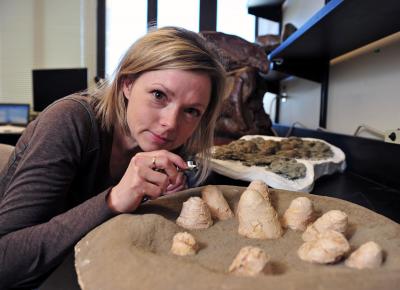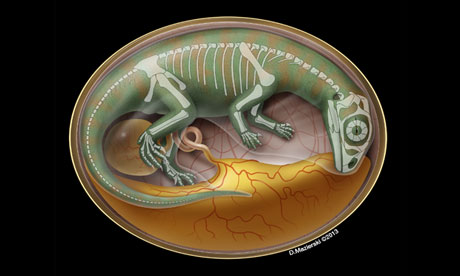
Darla
Zelenitsky from the University of Calgary collaborated with David
Varricchio at Montana State University to closely examined the shells of
fossil eggs from a small meat-eating dinosaur called Troodon.
Published: Thursday, April 18, 2013
Jay Im (University of Calgary).
Using egg clutches found in Alberta and Montana, researchers Darla Zelenitsky at the University of Calgary and David Varricchio at Montana State University closely examined the shells of fossil eggs from a small meat-eating dinosaur called Troodon.
In a finding published in the spring issue of Paleobiology, they concluded that this specific dinosaur species, which was known to lay its eggs almost vertically, would have only buried the egg bottoms in mud. "Based on our calculations, the eggshells of Troodon were very similar to those of brooding birds, which tells us that this dinosaur did not completely bury its eggs in nesting materials like crocodiles do," says study co-author Zelenitsky, assistant professor of geoscience. "Both the eggs and the surrounding sediments indicate only partial burial; thus an adult would have directly contacted the exposed parts of the eggs during incubation," says lead author Varricchio, associate professor of paleontology.
Varricchio says while the nesting style for Troodon is unusual, "there are similarities with a peculiar nester among birds called the Egyptian Plover that broods its eggs while they're partially buried in sandy substrate of the nest."
Paleontologists have always struggled to answer the question of how dinosaurs incubated their eggs, because of the scarcity of evidence for incubation behaviours. As dinosaurs' closest living relatives, crocodiles and birds offer some insights. Scientists know that crocodiles and birds that completely bury their eggs for hatching have eggs with many pores or holes in the eggshell, to allow for respiration. This is unlike brooding birds which don't bury their eggs; consequently, their eggs have far fewer pores.
The researchers counted and measured the pores in the shells of Troodon eggs to assess how water vapour would have been conducted through the shell compared with eggs from contemporary crocodiles, mound-nesting birds and brooding birds. They are optimistic their methods can be applied to other dinosaur species' fossil eggs to show how they may have been incubated. "For now, this particular study helps substantiate that some bird-like nesting behaviors evolved in meat-eating dinosaurs prior to the origin of birds. It also adds to the growing body of evidence that shows a close evolutionary relationship between birds and dinosaurs," Zelenitsky says.
source
###########################################################################
Dinosaur embryos twitched in their eggs like those of modern birds
A collection of embryos fossilised at various ages in different nests reveals how dinosaurs developed in the egg
- The Guardian,

A Lufengosaurus dinosaur embryo inside its egg. Illustration: D. Mazierski
The bones came from the genus known as Lufengosaurus, a long-necked dinosaur that could grow up to eight metres long, and were found among fragments of egg shells at a site near the city of Lufeng in Yunnan, south west China. They are the oldest dinosaur embryos ever found and seem to have come from several nests and from eggs at various stages of development. "Most of the time you get single glimpses of embryonic life in a dinosaur because they are preserved as a nest and all the eggs are in the same developmental stage," said Robert Reisz, a palaeontologist at the University of Toronto Mississauga, who led the team that analysed the bones. "Here we have a growth series of embryos, which allowed us to track how these animals grew."
The team's results are published in the journal Nature. Reisz's team focused their analysis on the largest bone, the femur. They found that, inside the eggs, these bones seemed to be growing very quickly, implying that their incubation period might have been relatively short.
Inside the bones is a honeycomb structure of "primary spaces". The larger these are, said Reisz, the faster the embryo would have grown. In addition, the scientists found that the bones were shaped inside the eggs, as they grew, as attached muscles pulled on them. "This suggests that dinosaurs, like modern birds, moved around inside their eggs," said Reisz. "It represents the first evidence of such movement in a dinosaur.
source

















No comments:
Post a Comment